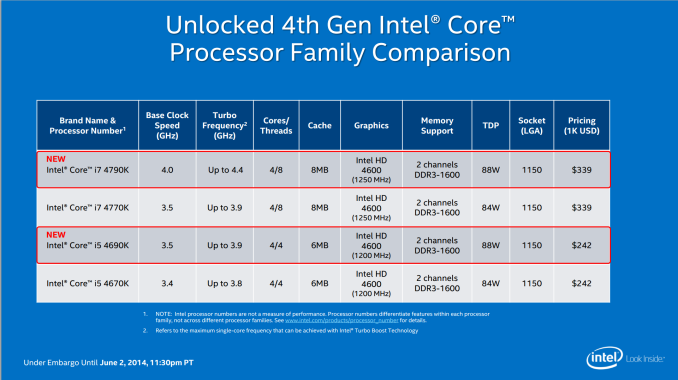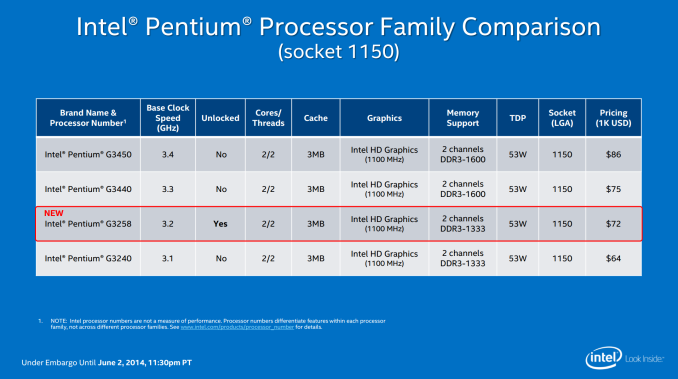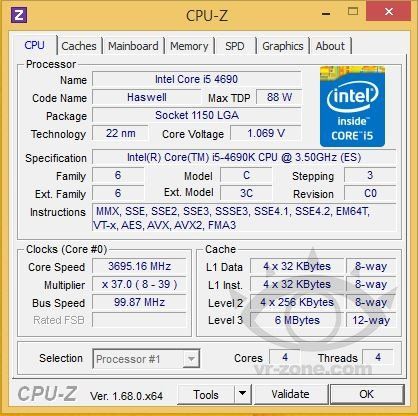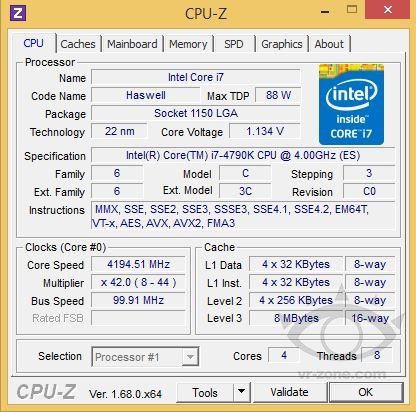Intel Launches Devil’s Canyon and Overclockable Pentium: i7-4790K, i5-4690K and G3258
by Ian Cutress on June 3, 2014 2:30 AM EST- Posted in
- CPUs
- Intel
- Haswell
- Devil's Canyon
- Computex 2014

After what seems like a eon or two since the original announcement, Intel’s Renée James is formally launching the new Devil’s Canyon and Anniversary Edition Pentium processors. In response to enthusiast feedback, and the recent release of the Z97 chipset motherboards, these new processors are designed to improve the overclocking experience for enthusiasts until the next platform enters production.
In the same way as certain other electronic market segments, where the announcement and launch occurs a few weeks before launch, today is actually a paper launch as part of the Computex experience. Review samples for sites like ours should be arriving sometime this week when we can test and dissect the new parts, with a full retailer release later in the month. At present the date is still uncertain: we were hoping to get samples before Computex in order to present results today, but delays have pushed testing and release later down the line. This is in part due to the restricted timescale for these new processors, whereby VP Lisa Graff in a recent press call stated that the Intel engineers had fewer than six months from idea-to-launch.
Devil’s Canyon, the codename for the upgraded Haswell overclocking ‘K’ series SKUs, launches as two parts: an i7 and an i5.
Both models are quad core parts, with the i7 featuring hyperthreading for a total of eight threads. The TDP has a small bump from 84W to 88W, while the official memory support stays at two channels of DDR3-1600. The i7-4790K represents Intel’s first ever consumer processor with a base frequency of 4 GHz (we have CPUs that turbo this high), but the turbo mode for this processor is actually 4-4-3-2, meaning that at single core loads the user will see 4.4 GHz and at full-core loads it will be 4.2 GHz. The i5 is more of a Haswell Refresh-like bump up from its predecessor, with the base frequency and turbo frequencies being moved up a notch.
Compatibility for these processors will be on all Z97 motherboards, and it should extend to Z87 if and only if the motherboard manufacturer has engineered the motherboard to cope with the increased power consumption and also release a relevant BIOS update. I would expect that all the major motherboard manufacturers should announce a full range of 9-series support and a most-of-the-range 8-series support, starting with the most popular products in the 8-series range first (as it all comes down to validation and rewriting BIOS code).
Aside from the base frequency increases, enthusiasts will want to know if the rumor regarding an upgraded package on the CPU is true. I can confirm that Intel has officially made the following changes:
The first upgrade is a new thermal interface material (TIM), which Intel is stating as a ‘next-generation polymer’. This would inevitably imply that the base material is silicone monomer, unless Intel has decided to do something fancy with a carbon-polymer based suspension. With this in mind, users looking to delid their CPUs might see a material the same color as the normal Haswell CPUs, but Intel is stating that this is a new material. One could estimate that another 5-15C shift might occur, allowing those CPUs that were temperature limited to get another 100-200 MHz than they would under the old system. However the issue regarding the height of the heatspreader above the die due to the binding agent has not been mentioned, which would lead me to suggest that it might not have been changed. Until we get a sample in house to test we will not know for sure, but I could perhaps hope that the amount of TIM under the heatspreader has also increased in order to facilitate heat transfer.
For the extreme overclockers using sub-zero cooling, Intel has reworked part of the power delivery around the FIVR to give a cleaner power delivery. Note that none of these changes suggest that any specific change to the underlying silicon die was made, however Intel will be examining the sales of these processors to determine their popularity and whether it is a feature to consider on future platform evolutions.
Also launched today is the new Pentium Processor Anniversary Edition, a fully unlocked 3.2 GHz dual core Pentium and 3MB of L3 cache.
I personally think Intel has missed a trick in not calling this new processor with a ‘K’ moniker, but the 8 on the end should point the CPU out against the myriad of other model names. At $72 for the bulk OEM pricing, this should allow the competitive overclockers to go almost crazy binning (testing to find the best ones) for competitions. The interesting point about the table above is the memory support, set at DDR3-1333. This means that Intel has used a lower bar of entry for the integrated memory controllers on the dies they produce, which might not end well for high memory clocking.
One point of contention for any user that has sought after a high overclocking Haswell CPU in the past is the silicon lottery, whereby CPUs are like chocolate chip cookies. Some cookies have many chips, others have fewer, but the ones made of pure chocolate are the best. Similar analogy to overclocking – some CPUs will hit higher frequencies at lower voltages than others. Haswell processors had a very large swing, with some of the lower performing CPUs (from 3.9 GHz Turbo) only managing 4.2 GHz on air/water cooling compared to the average (4.4-4.5 GHz) and the few awesome ones (5.0 GHz at 1.3 V). Many users tested a half-dozen or a dozen to get the best one of the bunch, and I fear that unless there has been a change at the silicon level, we may see the same with the Devil’s Canyon and Anniversary Pentium models.
CPU-Z screenshots of all three models have been released, confirming many of the details:
As I mentioned, the exact retail release date, as I am writing, is unknown. The embargo for this data is being released at the same time as the Intel Keynote at Computex which is where the official announcing of the new products is happening. Have a read of our live blog on the main page on the keynote to see if an exact date has been chosen! This post will be updated if we get this information.
When we return from Computex we will begin testing the new CPUs, with a plan to show some delidding and see how the new Devil’s Canyon and new Pentium compares to the regular Haswell CPUs both at stock and overclocked. Let me know in the comments if there is anything specific you would like to see in the review.





















53 Comments
View All Comments
Pheesh - Tuesday, June 3, 2014 - link
...how is it overhyped? Seems it's exactly what they said it would be.xrror - Tuesday, June 3, 2014 - link
Like others I was hoping for an unlocked crystalwell part.Even if it turned out not to help much, it still would be fun to see what overclockers could tweak/abuse out of the eDRAM as a L4 cache.
bludragon - Tuesday, June 3, 2014 - link
Nice to see confirmation of the high clock speeds on the i7. Even without overclocking that makes a nice upgrade in speed over the existing chips. Unfortunately this means I am now more tempted by the i7, rather than being able to save money and get almost the same performance with the i5.As for the underwhelming factor, yes, this is a minor upgrade to the existing Haswell chips, so if you already have Haswell, or even Sandy Bridge, upgrading will not make much difference. However, I am sitting on a core2duo and so my major dissappointment is that "mid year" has now passed and I am still waiting for reviews or even an availability date.
bludragon - Tuesday, June 3, 2014 - link
Just noticed that the Asus H81M-E supports the i7-4790k and it only has a 3 phase supply. I know... it can't OC, but it you can get it for <$60. So, rather than i5-4690k + $150 z97 mobo + fancy cooler, you could get the i7 and an H81M-E, a basic cooler and probably still have some money left over. Now the challenge is how to hack the H81 mobo to support multiplier OC?AnonymousGuy - Tuesday, June 3, 2014 - link
I direct-die watercool my 4770k, and I can tell you from my experience with 5 3770k's and 3 4770k's that Haswell is a dog when it comes to overclocking. I can throw 1.6V at it and not be able to get 4.8 Ghz stable, where my 100% load temps won't go above 50C.So the TIM upgrade doesn't matter to me. What does matter is whether the 4790K is really any different than a 4770k...2 ways this can happen. First, they can tweak the fab process a bit to get faster silicone / lower leakage. Second they can "bin" the die that somewhat-randomly have lower leakage and faster silicone as 4790k's and they'll overclock like monsters.
AnonymousGuy - Tuesday, June 3, 2014 - link
Forgot my main point: hopefully the 4790K is truly better silicon (either through fab process changes and/or improved binning/cherry picking) than a 4770k and it's not just a rebadged 4770K with better TIM and a higher stock clock speed which would still suck at overclocking for hardcore enthusiasts like me where temperature and voltage aren't the limiting factors.haukionkannel - Tuesday, June 3, 2014 - link
It is the same stepping as 4770K so it is only a rebadge. Hopefully it will last a little bit longer because it has better materials... It will not be faster, but maybe the deviation between chips is smaller, so not so big change to get a chip that overclock really poorly. Upper limit will remain the same though, because there are not improvements in that sector.AnonymousGuy - Tuesday, June 3, 2014 - link
5.498 Ghz from Team MSI presumably on air/water with all 4 cores enabled: http://hwbot.org/competition/intel_occ_computex14/Hopefully Intel didn't cherry pick die specifically for that event. Even if they did I haven't heard of anyone with a 4770k being able to get past 5.1 or 5.2 Ghz without phase change, dICE, or LN2.
MrSpadge - Wednesday, June 4, 2014 - link
If people are disappointed by this their expectations were really unrealistic. It's the same die, as nothing else would make economic sense. BUT it's got a massive clock speed advantage over any other current offering from Intel. This won't mean much for OC (unless it means stricter binning), but it can mean a lot for people running stock CPUs!This CPU is getting >10% more performance than any other desktop CPU. For lightly threaded workloads it's actually by far the fastest desktop CPU you can buy. I fail to see any reason to complain about this, even though I'd obviously rather have Broadwell + Crystal Well. But those will mean far higher cost for Intel, in contrast to this offering.
Choppedliver - Thursday, June 5, 2014 - link
I decided a few years ago my next upgrade would come when I could get >8 threads, ie hyperthreaded with more than 4 cores, and also not generate so much heat I could use it as a space heater... Getting closer . Anyone have any idea when we will see >4 cores in a lower tdp than the current 6 core i7's? those things are getting long in the tooth... 2011 , 39xx series